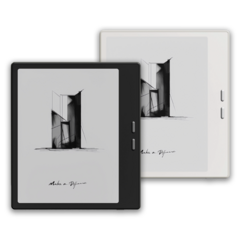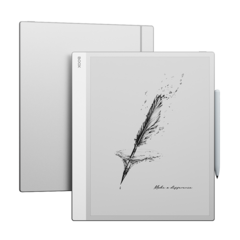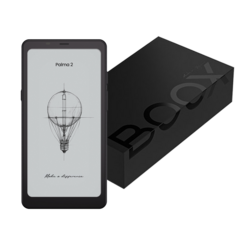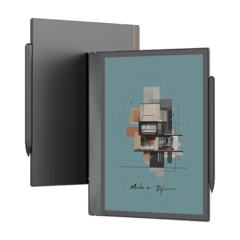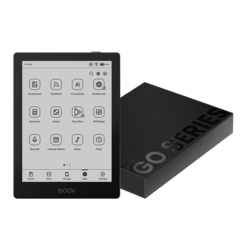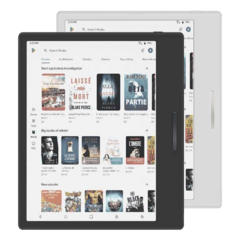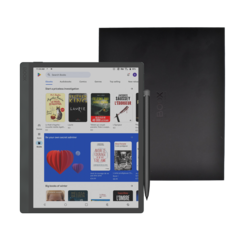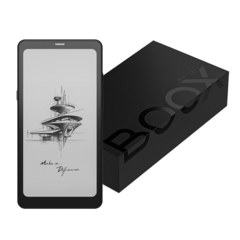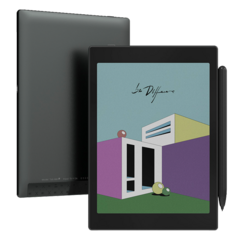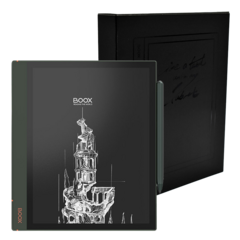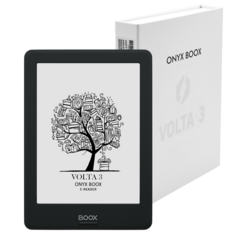Onyx Boox Note Air Review: an E-Reader That's Also a Full Android Tablet
- Source: businessinsider.com
- Author: Mark Knapp, 07.08.2021
- All rights reserved
The Onyx Boox Note Air is an e-reader for tinkerers. It blurs the line between a true e-reader and an Android tablet, offering the e-reader's specialized display without running on a locked-down fork of Android that limits utility. It may pigeonhole the Boox Note Air into a niche, but it stands out as a truly special product.
By using a 10.3-inch E Ink display, the Boox Note Air offers a tablet's worth of screen real estate for everything from ebooks and PDFs to magazines and word documents. By running Android, it also offers nearly limitless options for how to access content, or even to create content.
Being a bit of a unique device, the Boox Note Air doesn't come cheap. At $479, it's priced like some of the best Android tablets from Samsung or Lenovo, yet it lacks the level of power and versatility of those devices. And yet, with a battery-sipping E Ink display, a surprisingly elegant design, and a competitive digitizing layer, it's not a tablet to write off so quickly.
Design
The Boox Note Air is downright stunning. Onyx has made this tablet impressively thin and elegant, with a glass front and aluminum chassis that give it a premium air that fits the price point. Even the Boox Note Air's antenna line is given a bit of pizzazz with its sienna coloring. There is some bezel around the display and a larger gap on one side of the screen, but it gives it the feeling of being an actual notebook.
The Boox Note Air includes a power button, a USB-C port with On-The-Go (OTG) support for thumb drives, and a capable little speaker along the side with the widest bezel. Since the Boox Note Air can orient the display in any direction automatically, there is no left or right side, per se, so users can hold it as they find most comfortable.
The E Ink Carta HD display on the Boox Note Air is another point of excellence. It offers fairly sharp detail, making it easy to read even with fine, small text. Plus, that fineness lets it create different shades of gray, a trick that helps it work around its lack of color. The E Ink display is relatively bright (not overly gray) without Onyx's reading lights turned on. When in a dim environment, the reading lights improve visibility, and by combining lighting with two different tones, the color temperature is widely adjustable. There is a slight air gap creating a parallax effect on the display, but it's only noticeable at the very edges.

The Onyx Boox Note Air also comes with a stylus and supports 4,096 levels of pressure sensitivity. The stylus is stylish, but rather simple. It matches the aesthetic of the tablet, but it lacks any eraser or shortcut buttons. On the plus side, it does magnetically latch onto the Boox Note Air next to the display, which can also put the display to sleep.
Specifications
| Dimensions: | 9.03 x 7.69 x 0.23 inches |
| Weight: | 0.93 lbs |
| Display: | 10.3 inch E Ink: 1,872 x 1,404 Carta HD; Wacom digitizer |
| Processor: | Qualcomm Snapdragon 636 8-core 1.8GHz |
| Memory: | 3GB LPDDR4X |
| Storage: | 32GB eMMC |
| Operating system: | Android 10 |
| Speakers: | Mono |
| Battery: | 3000mAh, up to 4 weeks standby, Quick Charge 4.0 |
| Connectivity: | 802.11ac dual-band Wireless, Bluetooth 5.0, USB-C (OTG) |
Setup and interface
The Onyx Boox Note Air is ready from first boot. There's no special account setup needed to start reading ebooks or take notes. It comes preloaded with a few apps for these uses, as well as a web browser and basic app store. That said, to make the most of the device, there's a bit more work involved.
The Boox Note Air has a plastic screen protector that is a good idea to put on, but it doesn't come pre-applied. It may not be necessary, but the feel of the stylus on the screen protector is much more paper-like than directly on the glass.
And, even though the Boox Note Air runs Android, there are a couple hoops to jump through to enable the Google Play Store and get access to Android apps. It's a short process that takes 10-15 minutes, but it would have been nicer to have Google's app store present from the start. Having access to the breadth of Google Play Android apps is worth it and a big part of what sets the Boox Note Air apart from other e-readers and E Ink tablets like the Remarkable or the Kindle Oasis.
Some of the Boox Note Air's interface will be familiar for Android users. The launcher is specialized, with different groupings along the left side of the home screen. The notification shade is very much like what you'd find on other Android devices, though. There is a special floating button, called the Navigation Ball, that can be positioned anywhere on the screen and provides navigation controls and shortcuts. Otherwise, swiping up from the bottom of the screen provides some basic navigation.

You'll also find settings like Wi-Fi, Bluetooth, volume, and orientation in the quick settings menu. A special addition to this menu is the screen refresh, as E Ink operates differently from traditional LCD or OLED displays. Since different applications can benefit from different screen refresh styles, this shortcut makes it quick to change on the fly.
Performance and features
The Onyx Boox Note Air is an Android tablet, but it doesn't always feel like any old Android tablet. It's impressive that it comes running Android 10 and is powered by a Snapdragon 636 chipset. It's no performance beast, and occasionally can feel a little sluggish to launch apps, but part of that can come down to the slower response of the display. Still, the device has been fast and powerful enough to boot up quickly and to run Google Docs, YouTube, Kindle, and Khan Academy alike. It can even enter split-screen mode to handily run the built-in note app side-by-side with another app.
It's easy to forgive some of this sluggishness though, as this tablet isn't a sprinter but rather a marathon runner. It reaps some of the benefits of an Android tablet, especially when it comes to text-based mediums, and pairs them with the huge perk of e-readers: battery life.
The Boox Note Air can sip on its battery all day. And, unlike a traditional display that requires more power to view in brighter environments (like outdoors), the Boox Note Air display is only easier to see as the environment gets brighter. This opens the door for some special use cases, as it is a competent device for drafting up documents, taking notes, and fielding emails, thanks to its support for a Bluetooth keyboard and just about whatever Android app you want to install on it. This very review was written out in the sun on the Boox Note Air.

On a single charge, I read a 200 page book with the lights on and it barely made a dent in the battery. Between that, some mixed use, and writing up this review in a Google Doc with Bluetooth and 5GHz Wi-Fi connected (a total of over 8.5 hours of active use) the battery had only drained by 37%.
As well as the Boox Note Air works for text-based tasks, it's impressive how passably it can handle graphical media. Fine lines and shades of gray go a long way toward presenting a decent image, and I often found the grayscale book covers in the Kindle app were easier to make out than the colored alternative on the Onyx Boox Nova3 Color. The Boox Note Air's faster refresh modes even make video an option, though the fastest setting comes with a lot of ghosting that ruins text.
Fortunately, Onyx has nailed one thing. The stylus support in the stock reader and notes apps is phenomenal. Even if the display refresh mode isn't at its fastest, the screen's response to the stylus is near instantaneous. It feels like writing on paper. Those wanting to get a bit creative in third-party apps will likely find the increased input latency a bit more problematic, though the lack of color would likely be more of a dealbreaker. That said, the stock notes app is fairly feature-rich and you can export the notes to use elsewhere.
The bottom line
The Onyx Boox Note Air is a special device. It may not replace a computer or tablet in every case, but for everything text-based, it's phenomenal. Whether reading novels, taking notes on PDFs, or writing documents, the Boox Note Air is a trusty partner with a battery life that other devices with backlit screens just won't come close to. It won't be for everyone, but it'll be a real treat for the people that need what it offers.

Should you buy it?
For some, the simple combination of an E Ink display with a quality digitizer and support for keyboards may be enough reason to buy this tablet. As a simple e-reader, it may be overly large and expensive. And, it doesn't have the same versatility as an Android tablet. But, for writers and editors, there's probably no device more magical.
What are your alternatives?
If all the perks of Android are not must-haves, the Remarkable 2 is a similarly sized E Ink tablet with a digitizing layer for taking notes. At $399 for the tablet itself and $49 for the stylus, it's only offering small savings for the loss in versatility, though.
If you can't quite live without color, the Onyx Boox Nova3 Color runs a lot of the same hardware and software, but features a color LCD layer over the E Ink display, giving it a bit of both. The E Ink ends up a bit dimmer, and the color isn't incredibly sharp, but there are some considerable perks to having color available. This tablet is a bit smaller and not as elegantly designed, but it's also cheaper.
Pros: Amazingly capable e-reader, Wacom digitizing layer, marathon battery, excellent E Ink display, runs Android 10, elegant design, two-tone reading lights.
Cons: Expensive for an e-reader, grayscale not always a substitute for color, ghosting with higher refresh, no eraser or buttons on stylus, workaround required for Google services

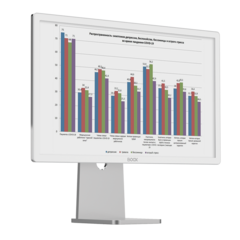

_announce_600x600-240x240.png)
